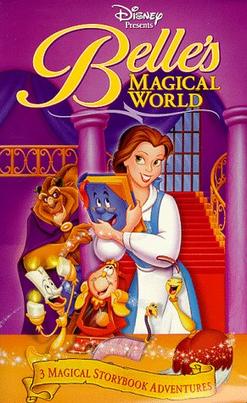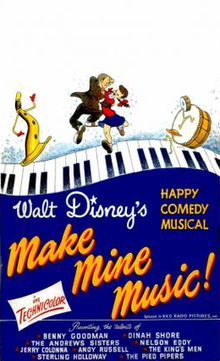
Song of the South is a 1946 American live-action/animated musical drama film directed by Harve Foster and Wilfred Jackson; produced by Walt Disney and released by RKO Radio Pictures. It is based on the Uncle Remus stories as adapted by Joel Chandler Harris, and stars James Baskett as Uncle Remus in his final film role. The film takes place in the U.S. state of Georgia during the Reconstruction era, a period of American history after the end of the American Civil War and the abolition of slavery. The story follows seven-year-old Johnny who is visiting his grandmother's plantation for an extended stay. Johnny befriends Uncle Remus, an elderly worker on the plantation, and takes joy in hearing his tales about the adventures of Br'er Rabbit, Br'er Fox, and Br'er Bear. Johnny learns from the stories how to cope with the challenges he is experiencing while living on the plantation.

The Three Caballeros is a 1944 American live-action and animated musical propaganda anthology film produced by Walt Disney and released by RKO Radio Pictures. The film premiered in Mexico City on December 21, 1944. It was released in the United States on February 3, 1945 and in the United Kingdom in March 1945. It marks the tenth anniversary of Donald Duck and plots an adventure through parts of Latin America, combining live-action and animation. This is the second of the six package films released by Walt Disney Productions in the 1940s, following Saludos Amigos (1942). It is also notable for being one of the first feature-length films to incorporate traditional animation with live-action actors.

Cinderella is a 1950 American animated musical fantasy film produced by Walt Disney Productions and released by RKO Radio Pictures. Based on Charles Perrault's 1697 fairy tale, it features supervision by Ben Sharpsteen. The film was directed by Wilfred Jackson, Hamilton Luske, and Clyde Geronimi. The film features the voices of Ilene Woods, Eleanor Audley, Verna Felton, Rhoda Williams, James MacDonald, and Luis van Rooten.

The Little Mermaid is an American animated musical television series produced by Walt Disney Television Animation based on the 1989 animated feature film of the same name. It features the adventures of Ariel as a mermaid prior to the events of the film. This series is the third Disney television series to be spun off from a major animated film. Some of the voice actors of the film reprise their roles in the series, among them Jodi Benson as Ariel, Samuel E. Wright as Sebastian, Kenneth Mars as King Triton, and Pat Carroll as Ursula. Other voice actors include Edan Gross as Flounder, and Jeff Bennett as Prince Eric.

Fantasia 2000 is a 1999 American animated musical anthology film produced by Walt Disney Feature Animation and released by Walt Disney Pictures. Produced by Roy E. Disney and Donald W. Ernst, it is the sequel to Disney's 1940 animated feature film Fantasia. Like its predecessor, Fantasia 2000 consists of animated segments set to pieces of classical music. Segments are introduced by celebrities including Steve Martin, Itzhak Perlman, Quincy Jones, Bette Midler, James Earl Jones, Penn & Teller, James Levine, and Angela Lansbury in live action scenes directed by Don Hahn.

Fun and Fancy Free is a 1947 American animated musical fantasy anthology film produced by Walt Disney and Ben Sharpsteen and released on September 27, 1947 by RKO Radio Pictures. The film is a compilation of two stories: Bongo, narrated by Dinah Shore and loosely based on the short story "Little Bear Bongo" by Sinclair Lewis; and Mickey and the Beanstalk, narrated by Edgar Bergen and based on the "Jack and the Beanstalk" fairy tale. Though the film is primarily animated, it also uses live-action segments starring Edgar Bergen to join its two stories.

The Many Adventures of Winnie the Pooh is a 1977 American animated musical anthology comedy film produced by Walt Disney Productions and distributed by Buena Vista Distribution. It was first released on a double bill with The Littlest Horse Thieves on March 11, 1977.

Melody Time is a 1948 American live-action and animated musical anthology film produced by Walt Disney. It was released to theatres by RKO Radio Pictures on May 27, 1948. Made up of seven segments set to popular music and folk music, the film is, like Make Mine Music before it, the popular music version of Fantasia. Melody Time, while not meeting the artistic accomplishments of Fantasia, was mildly successful.
John Ryan Kinney was an American animator, director and producer of animated shorts. Kinney is the older brother of fellow Disney animator Dick Kinney.

A Symposium on Popular Songs is a special cartoon featurette made by Walt Disney Productions in 1962. It features songs that were written by the Sherman Brothers, with music arrangements by Tutti Camarata. The Shermans also co-wrote the screenplay but are not credited for this. Host Ludwig Von Drake invites his audience into his mansion where he tells all about popular music through the years, introducing several songs illustrated with stop-motion photography. The film was nominated for an Academy Award for Best Animated Short Film.

Beauty and the Beast: Belle's Magical World is a 1998 direct-to-video animated musical film produced by Walt Disney Television Animation. It was released on February 17, 1998, and it is the sequel to Disney's 1991 animated feature film Beauty and the Beast and the third in the Beauty and the Beast films, featuring the voices of David Ogden Stiers as Cogsworth, Robby Benson as The Beast, Gregory Grudt, who replaced Bradley Pierce as Chip Potts, Paige O'Hara as Belle, Anne Rogers, who replaced Angela Lansbury as Mrs. Potts, and Jerry Orbach as Lumiere. The film features two songs performed by Belle, "Listen With Our Hearts" and "A Little Thought." This storyline is set within the timeline of the original Beauty and the Beast.

Lambert the Sheepish Lion is a Disney animated short film that was released in 1952. It was directed by Jack Hannah.
Madeline is an animated preschool television series produced by DIC Entertainment, L.P., part of the Madeline media franchise. It began as a series of six television specials from 1988 to 1991, and then continued as Madeline and The New Adventures of Madeline from 1993 to 2001. The show is narrated by Christopher Plummer.
Music Land is a Silly Symphony animated Disney short released in 1935.

Peter and the Wolf is a 1946 animated short based on the 1936 musical composition/fairy tale by Sergei Prokofiev, produced by Walt Disney and narrated by Sterling Holloway. It was originally released theatrically as a segment in Make Mine Music. It was re-issued the following year accompanying a re-issue of Fantasia, then released separately on home video in the 1990s.

Steamboat Willie is a 1928 American animated short film directed by Walt Disney and Ub Iwerks. It was produced in black and white by Walt Disney Studio and was released by Pat Powers, under the name of Celebrity Productions. The cartoon is considered the debut of both Mickey and Minnie Mouse, although both characters appeared several months earlier in a test screening of Plane Crazy. Steamboat Willie was the third of Mickey's films to be produced, but it was the first to be distributed, because Disney, having seen The Jazz Singer, had committed himself to produce one of the first fully synchronized sound cartoons.
Hamilton Somers Luske was an American animator and film director.

Ferdinand the Bull is a 1938 American stand-alone animated short produced by Walt Disney Productions and released on November 25, 1938, by RKO Radio Pictures. It was directed by Dick Rickard and based on the 1936 book The Story of Ferdinand by Munro Leaf. The music was by Albert Hay Malotte, most known for his setting of The Lord's Prayer, commonly sung at weddings.

Father Noah's Ark is a Walt Disney Silly Symphonies animated film. It is based on the story of Noah's Ark. The short's musical score is an adaptation of the first dance in Ludwig van Beethoven's 12 Contredanses. The cartoon was released on April 8, 1933.

Farmyard Symphony is a 1938 Silly Symphonies animated short film. It can be seen as a precursor to Fantasia due to using various pieces of classical music in one short. The film was directed by Jack Cutting and produced by Walt Disney.
















